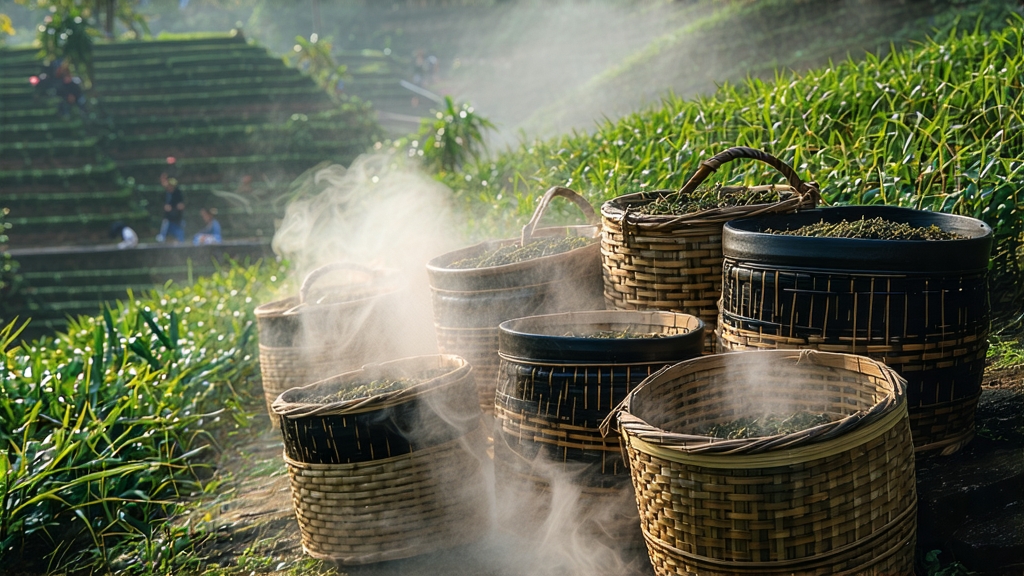
Tucked away in the subtropical hills of southern China, Liu Bao tea has spent four centuries perfecting the art of quiet transformation. To most Western drinkers “dark tea” begins and ends with shou Pu-erh, yet Liu Bao is the older, gentler sibling that once rode the same horse caravans, sailed the same junks, and financed the same riverbank teahouses. Its story is one of geology, humidity, and human patience—an edible time capsule that tastes of camphor, molasses, and the cool breath of a limestone cave.
-
From Military Ration to Maritime Currency
During the Qing dynasty the Qing court needed a tea that could survive the month-long trek from Guangdong to the garrisons of Yunnan and Tibet. Compressed into 37 kg bamboo baskets, Liu Bao’s low moisture and active microflora resisted mold while acquiring a deep, comforting sweetness. By the late 1800s the same baskets were bartered in Hong Kong dockyards for opium, spices, and eventually gold; British records list “Lew Pao” among the teas re-exported to Southeast Asia where it became the breakfast drink of tin miners and rubber tappers. The name itself simply means “Six Forts,” a nod to the six ancient stockades that once protected the little river town of Wuzhou. -
Terroir: Where Karst Meets Humidity
The minuscule Liu Bao appellation—barely 30 km from lip to lip—sits on a seam of Devonian limestone riddled with underground streams. Daytime temperatures hover at 28 °C with 85 % relative humidity, ideal for the slow, aerobic fermentation that begins the moment the leaf is picked. Local cultivars (Camellia sinensis var. sinensis, clones GX-1 and GX-7) have evolved thicker cuticles and higher polyphenol oxidase activity, biochemical armor against the relentless damp. When rain sweeps in from the Xi River the mountain traps the cloud, creating a natural “wet piling” incubator centuries before human artisans formalized the technique. -
Craft: The Rhythm of Water, Heat, and Rest
Liu Bao is not “post-fermented” in the casual sense; it is guided through a precisely choreographed microbial waltz.
a. Wilting under Moonlight
Leaves are spread on bamboo screens for 4–6 hours, long enough to lose the grassy edge but short enough to retain the purple stem that signals high anthocyanin content.
b. Kill-Green at 280 °C
A two-minute tumble in a waist-high, coal-heated drum halts oxidation yet leaves a 7 % moisture window—critical for the next microbial inoculation.
c. Rolling & Oxidative Pause
The bruised leaf is piled 30 cm deep and covered with jute sacks for 45 minutes. Enzymes convert catechins into theaflavins, laying the groundwork for the signature “betel-nut” aroma.
d. Wet Piling: The 25-Day Secret
Now the leaf is sprayed with mineral-rich karst water, stacked 1 m high, and turned every five days. Thermophilic Bacillus subtilis and Aspergillus niger rise and fall like civilizations, pushing temperature to 55 °C before cooling. The pile never goes anaerobic; oxygen slips in through bamboo slats, preventing the swampy off-notes that can plague inferior dark teas.
e. Drying with Camphor Smoke
Basket-lined tunnels channel smoke from slowly smoldering camphor wood. The resinous vapor sterilizes the leaf while gifting a cooling, medicinal top note that lingers in the throat.
f. Basket Compression & Cave Aging
Semi-dry leaf (12 % moisture) is tamped into plaited bamboo baskets lined with wild banana leaf. These 37 kg “lan” are moved to natural limestone caves where relative humidity stays at 75 % year-round. For a minimum of three years the tea breathes, sweats, and contracts, emerging with a dusty white bloom (Eurotium cristatum) prized by connoisseurs as “golden flowers.”
- Grades & Styles
- San Jian (Three Tips): Only the bud and first two leaves, yielding a silky liquor with hints of dried longan.
- Te Ji (Special Grade): One bud / three leaves, wet-piled 28 days for deeper bass notes of cacao